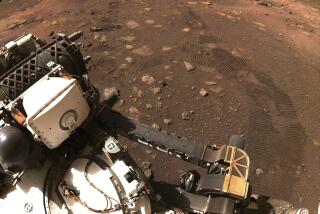Confessions of a Mars Skeptic
- Share via
The claims from the NASA-Stanford team were extraordinary: the first “semi-hard” evidence of life elsewhere in the universe. Some hailed the Mars rock as a “defining moment in human history.” Public reaction was immediate: “Wow!” “Cool!” “Excellent!” To some, the impact on religion is of cardinal importance. To others, the primacy of humankind. To all, our place in the cosmos seems held in the balance. Heady stuff.
My task--at the request of NASA--was to offer expert opinion on the validity of their conclusions. I did so as dispassionately as I could: “Interesting. Exciting. But circumstantial, inconclusive.”
The evidence for this claim of possible life on Mars, as yet, is not by any measure extraordinary. The emperor is clothed, but only barely. But my saying so led me to be dubbed by the press a “scientific naysayer.” To at least some people, I’m a snake in the grass.
Just after the press conference announcing the finds, I appeared live on a call-in show on CNN. During a program break, a woman in the audience asked: “Why can’t we be more positive about this new find? This is good news, great news! Those skeptics [me] ought to leave us alone.” Three days later, I called my mother. After chastising me for not phoning her sooner, she opined: “There may well be life on Mars. Son, keep an open mind!”
My mom and the lady on CNN evidently felt I was wrong in not wanting to believe. I’m afraid they missed the point. Science is not in the belief business. Feel-good solutions don’t count. The goal is to understand, to establish beyond doubt, to know, and that requires hard-nosed, down-to-Earth reasoning. Our knowledge of nature cannot progress unless we get the story straight. Carl Sagan is right: Extraordinary claims do require extraordinary evidence. And therein lies the rub.
The problem is that not one of the four lines of evidence claimed to support this find can stand alone. None can be regarded as definite proof, even in an Earth rock. Each is consistent with the presence of life, but each also with its absence. To some, the glass is half full. To others, half empty. Yet no one who knows the facts--including, notably, the scientists who did the work--would claim that the glass is overflowing.
As in international diplomacy, our stance should be, “Trust but verify.” Dan Goldin, the NASA administrator, has invited scientists worldwide to participate in validating the research facts reported by the team. This is bound to be successful--the science team has done a careful job. But unless new facts turn up, the glass will remain unfilled. What we need is an irrefutable line of evidence--demonstrably biologic cells, telltale signs of cell reproduction, unmistakable chemical signatures of life--something extraordinary to confirm this truly extraordinary claim.






